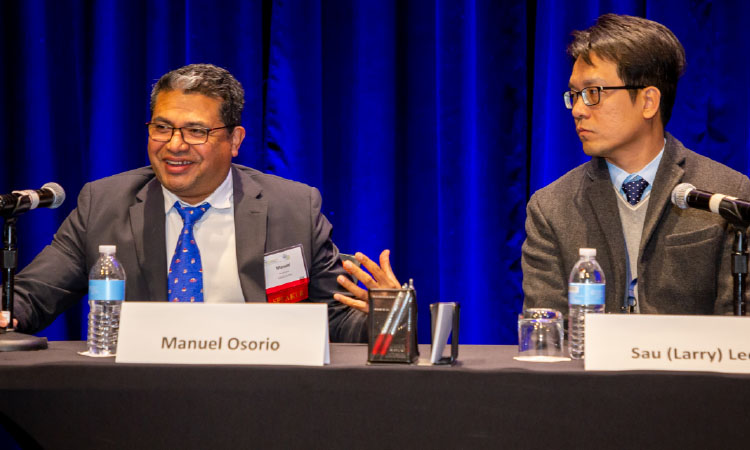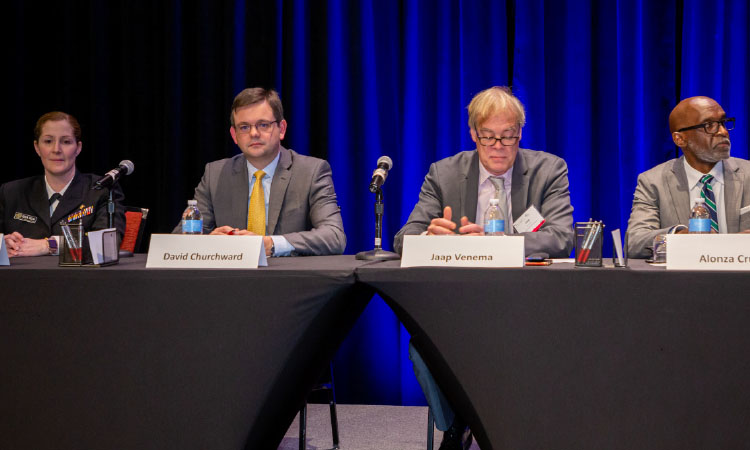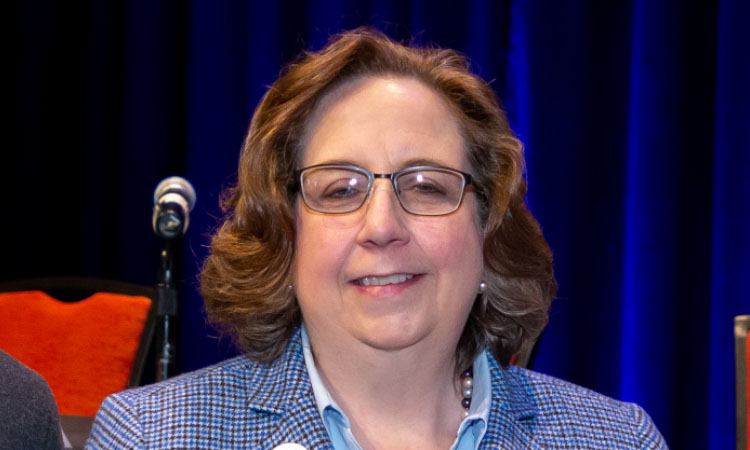Regulators Address Innovations & Harmonization

At the 2019 ISPE Global Pharmaceutical Regulatory Summit, regulators updated attendees on approaches to industry innovations and the ongoing work on harmonization and reliance around the world.
The conference, held on 5–6 December 2019 in North Bethesda, Maryland, included sessions on many regulatory-related topics. Here are some of the highlights from regulatory presentations and panel discussions during two plenary sessions on 6 December.
Regulatory and Industry Innovations
The first plenary, “Regulatory and Industry Innovations,” featured panel members from the US FDA Center for Drug Evaluation and Research (CDER) and Center for Biologics Evaluation and Research (CBER) emerging technology initiatives. Christine Moore, PhD, Global Head and Executive Director, GRACS CMC Policy, Merck & Co., Inc., was the session leader.
Center for Drug Evaluation and Research and Emerging Technology Team
Sau (Larry) Lee, PhD, Director and Emerging Technology Team Chair of Center for Drug Evaluation and Research’s Office of Testing and Research, shared insights into the Center for Drug Evaluation and Research approach to pharmaceutical innovation, especially in the chemistry, manufacturing, and controls (CMC) area. Center for Drug Evaluation and Research wants to facilitate and promote pharmaceutical innovation and established the Emerging Technology Program, led by the Emerging Technology Team (ETT), to achieve this end. Emerging Technology Team has a centralized focus and is a collaborative platform in the FDA and between the FDA and the pharma industry.
Emerging Technology Team is a cross-functional team with representation from all relevant FDA areas: the Office of Pharmaceutical Quality (OPQ) and the Office of Compliance (OC), which are both part of Center for Drug Evaluation and Research, and the Office of Regulatory Affairs (ORA). All team members have extensive experience in review, and many also have extensive experience in industry, which Lee noted is very important for working with reviewers, investigators, and the industry. The team can also recruit subject matter experts from other FDA offices as needed.
Emerging Technology Team addresses development, manufacturing of technology for generic, biological, and biosimilar products. Another initiative is pursuing harmonization by engaging with international agencies to facilitate/ share information.
Lee noted that Emerging Technology Team will be involved in the entire application/evaluation process, starting with presubmission meetings. “The best way to learn the technology is to see it, and we need to work with industry to ask relevant questions and see the technology.” Emerging Technology Team is also involved in integrated quality assessment (application review and preapproval inspection). Continual involvement of Emerging Technology Team members throughout the process is very important, Lee not-ed, because it helps avoid inconsistency in evaluation of emerging technology and minimizes the risk of giving inconsistent recommendations to the industry.
Lee pointed out that early engagement can even start without an identified drug candidate, which is very different from the investigational new drug (IND) process. There is no prescriptive process for emerging technology, but the sponsor must justify how the proposed technology meets two criteria: pharmaceutical novelty and product quality advancement.
Lee suggested that companies preparing for an Emerging Technology Team meeting should “be transparent and willing to share with the agency early. Don’t be afraid to get and answer many questions,” he said. The goal is to achieve a common understanding and to see regulators as part of the team.
Lee stressed that the FDA is willing to learn. It wants to understand and recognize the potential of new technology with an open mind, make science- and risk-based assessments and decisions, and be transparent to the industry. To that end, the agency is not afraid to ask questions and is taking a multidisciplinary, collaborative approach to emerging technology. Lee noted that feedback from current and past participants has indicated high overall satisfaction ratings on value, process, and awareness in working with Emerging Technology Team.
For further information on Emerging Technology Team, Lee directed attendees to two FDA guidance documents: “Advancement of Emerging Technology Applications for Pharmaceutical Innovation and Modernization Guidance for Industry”1 and “Center for Drug Evaluation and Research Manual of Policies and Procedures (MAPPs).”2 He said these documents explain what Emerging Technology Team is and offer more specifics about sponsor processes to engage and get early feedback from the FDA.
Center for Biologics Evaluation and Research and Center for Biologics Evaluation and Research Advanced Technologies Team
Manuel Osorio, PhD, Senior Scientist for Emerging Technologies and Medical Countermeasures, Center for Biologics Evaluation and Research Advanced Technologies Team (CATT), spoke on “Advanced Manufacturing of Complex Biologics: A Center for Biologics Evaluation and Research Perspective.” He shared information about Center for Biologics Evaluation and Research Advanced Technologies Team, the new Center for Biologics Evaluation and Research team addressing emerging technologies.
He noted that Center for Biologics Evaluation and Research agrees with many of the messages from Lee’s presentation: both Center for Drug Evaluation and Research and Center for Biologics Evaluation and Research are committed to developing new technologies. However, there are also differences between Center for Biologics Evaluation and Research Advanced Technologies Team and Emerging Technology Team, Osorio said. Center for Biologics Evaluation and Research focuses on complex biologics, and Center for Biologics Evaluation and Research Advanced Technologies Team works with advanced manufacturing technologies, including 3D bioprinting, continuous manufacturing, cell culture systems supporting large-scale or rapid production, and monitoring/measurement technologies.
According to Osorio, challenges in cell and gene therapy include the lack of capacity for manufacture of lentiviral and adeno-associated virus vectors, which is limiting clinical development. Also, the process of production in current cell lines is still not able to meet demand. Center for Biologics Evaluation and Research is committed to supporting research and collaborating to try to address these issues, he said. For example, modernizing vaccine production by including advanced manufacturing technology could improve agility to respond to pathogens.
“Early engagement for new therapies is very critical,” Osorio said. “It provides the way for us to learn about new approaches and for industry to minimize risks of implementing new manufacturing technologies.” About 18 months prior to the conference, Center for Biologics Evaluation and Research created the Initial Targeted Engagement for Regulatory Advice on Center for Biologics Evaluation and Research producTs (INTERACT) Program3, 4 for potential sponsors to engage early with Center for Biologics Evaluation and Research staff and receive their input. The input is nonbinding, and the early-stage development communications replace the “pre pre-IND meeting.” The purpose of INTERACT meetings is to have important product-specific discussions about CMC, pharmacology/toxicology, and clinical issues, he said. These talks precede the pre-IND phase or the formal regulatory advice phases. (See reference 3 for more information on the INTERACT Program.)

Created in June 2019, Center for Biologics Evaluation and Research Advanced Technologies Team includes members from each review office in Center for Biologics Evaluation and Research; most team members are division/office directors or deputy directors. The team prioritizes building internal science and regulatory expertise and promoting the creation of modernized domestic manufacturing.
The scope of requests to Center for Biologics Evaluation and Research Advanced Technologies Team from prospective developers of novel therapies includes innovative approaches to biologic development, such as novel technologies that can significantly impact product development, as well as manufacturing process and control strategies with potential regulatory implications. When a request is received by the INTERACT program, a monthly work group meeting discusses the submission and decides how to address it and respond. The response may be an email or a meeting invitation, depending on whether the request is about a novel technology and if Center for Biologics Evaluation and Research Advanced Technologies Team has the resources to address it.
Osorio emphasized that the FDA is building internal science and regulatory expertise by developing and supporting the Center for Biologics Evaluation and Research research program, hiring new principal investigators to develop research projects and regulatory expertise, and hiring additional full-time reviewers. Center for Biologics Evaluation and Research also is establishing an advanced technologies seminar series and hosts academic and industry experts in advanced manufacturing technologies, who come to the FDA campus to educate the staff.
Having partners for inspections lets the FDA focus on other high-risk areas.
Center for Biologics Evaluation and Research is promoting the creation of modernized domestic manufacturing through Center for Biologics Evaluation and Research grants and contracts to support research projects studying improvements for advanced manufacturing of biological products. Funded research addresses knowledge and experience gaps identified for emerging manufacturing and testing technologies and supports the development and adoption of such technologies in the biological product sector. To date, Center for Biologics Evaluation and Research has awarded about $12 million to support research outside of the FDA.
Ongoing Center for Biologics Evaluation and Research initiatives include keeping pace with advancing technologies, refining the regulatory framework as necessary, overcoming limits in manufacturing, collaborating in the US and internationally on initiatives such as ICH Q13 and harmonized guidance on continuous manufacturing, and facilitating optimal product development.
Center for Biologics Evaluation and Research Advanced Technologies Team and Emerging Technology Team will meet quarterly to share information, Lee said, and Osorio noted manufacturing at point of care is the first topic to be addressed, as it affects both Center for Drug Evaluation and Research and Center for Biologics Evaluation and Research.
Global Reliance and Harmonization
The closing plenary of the conference, “Global Reliance and Harmonization,” included presentations from FDA and United States Pharmacopeia (USP) representatives followed by a panel discussions among presenters and other regulators. The session leader was Søren Pedersen, PhD, Senior Director, External Affairs, Quality Intelligence and Inspection, NovoNordisk A/S. In introductory remarks, he noted the great importance of regulatory convergence, but also reminded the audience that many efforts remain fragmented and uncoordinated: duplicate GMP inspections, many different GMP requirements, many different pharmacopoeias, different registration dossiers, and postapproval change differences, just to name a few.
MRAs
Mutual recognition agreements (MRAs) are one approach to eliminating duplication and increasing input from the partnering regulatory organizations. Alonza Cruse, Director, Office of Pharmaceutical Quality Operations, ORA, FDA, presented on “The Impact of the US-EU MRA on Pharmaceutical Inspections” and other FDA actions to increase harmonization.
Cruse spoke about changes within the FDA itself in recent years, including improved consistency and transparency of inspections, providing decision-al letters to inspected facilities with classification about the inspections, and looking to shorten time frames where enforcement or other actions have to happen so that such actions occur rather quickly.
The FDA is seeking to harmonize standards and work cooperatively with industry, academia, and regulators around the world, Cruse said. The MRA between the FDA and the EU is one action toward that goal. Implemented on 1 November 2017, it allows reliance by drug inspectors on information from their respective drug inspection authorities (FDA and EU). As of July 2019, 28 EU countries were participating (with provision for a stand-alone US-UK MRA after the UK left the EU). In addition to the MRA with the EU, the FDA may use inspection reports from other regulatory bodies in certain circumstances, usually when a US State Department warning has been issued or another event prevents FDA inspectors from physically visiting a facility.
Cruse described how the FDA interacts with partners on inspection reports, including the site selection inspection list generated for foreign and domestic sites. When the list comes, FDA checks all MRA countries on the list for any recent inspection or an inspection done within a close time frame, and if there is a report for translation and review that is similar to what would be done in an FDA-generated report. Having partners for inspections lets the FDA focus on other high-risk areas, Cruse noted.
The FDA reviews inspection reports because it is responsible for suitability of drugs intended for US patients, and it uses EU reports just as it uses FDA inspection reports to evaluate conformance with GMP. The reports help the FDA assess applications for marketing new drugs, determine a site’s overall state of quality, and identify risks to drug availability. The FDA is evaluating whether to extend MRAs beyond human drugs to cover veterinary drugs as well. This could increase collaboration, Cruse said.
PIC/S
The FDA is also working across borders on regulatory harmonization within the Pharmaceutical Inspection Co-operation Scheme (PIC/S), which has 52 member participating authorities, including the FDA. The FDA has been involved with developing a PIC/S training academy to train inspectors around the world on best practices in GMP assessments. The goal is more harmonization in inspections.
NIPP
Cruse gave an overview of the FDA’s New Inspection Protocol Project (NIPP),5 which embodies the desire for a better paradigm for the state of quality and compliance with cGMP. NIPP has already been implemented for sterile preapproval and surveillance, which were selected as the first area of focus due to perceived high risk.

The goal of NIPP is to modernize drug inspections by collecting and analyzing data in real time to give the FDA better information on the state of quality in drug manufacturing facilities and help in regulatory and application decisions. It supports consistent and comprehensive coverage of critical areas, uses a more structured and consistent electronic format, and provides up-to-date technical information and resources for investigators.
One challenge to harmonization is that it is resource intensive. Other challenges include time, priority misalignment, technical and regulatory hurdles, and revision hesitance.
The initiative will provide more quality, streamlined inspection reports and increase the quality focus of assessments to highlight what facilities are doing well, Cruse said. This is a departure from how inspectors are trained, which is to identify what is not going well, what is missing, or deviations.
NIPP will expand to other dosage forms, Cruse said. Protocols are under development are oral nonsterile dosage and transdermal products, creams, lotions, and active pharmaceutical ingredients (APIs). Some of these protocols may be rolled out in 2020 as pilots.
Pharmacopeial Collaboration and Harmonization
Jaap Venema, PhD, Executive Vice President and Chief Science Officer, USP, presented on “Pharmacopeial Collaboration and Harmonization from the USP Perspective.”
He provided background on USP, whose mission is to improve global health through public standards and related programs to help ensure quality, safety, and benefit of foods and other products. Public standards have value for many reasons, Venema explained. They provide a scientific basis for regulatory review, manufacturing, and enforcement decisions; they contribute to research and development, fostering innovation; they ensure a consistent approach to quality for innovator and generic products; they provide a basis for assessing the quality of drug products in commerce; and they help with monitoring for counterfeit and substandard products and quality of imported drug products.
USP works in collaboration with ICH, the World Health Organization (WHO), the FDA, other national regulatory authorities, industry stakeholders, and expert volunteers toward harmonization of global pharmacopeias. Effective pharmacopeial collaboration is valuable because it promotes access to quality medicines by leveraging global expertise; increases the value of public quality standards; facilitates global access to state-of-the-industry technology; prioritizes balancing current paradigms and future trends; and enables global pharmaceutical trade.
The USP Adopt Framework grants the rights to copy and adapt USP standards into other pharmacopeias. USP has agreements with multiple countries. Another area for collaboration is the Pharmacopeial Discussion Group (PDG) among Europe, Japanese, and US pharmacopoeias and WHO (as an observer). The focus is on harmonizing general chapters and excipient monographs, and pharmacopeial discussion group is making steady progress through retrospective harmonization: 45 excipient monographs and 21 general chapters have been completed. Pharmacopeial discussion group can also help resolve issues with standards that have been stalled or are not being leveraged effectively.
Going forward, pharmacopeial discussion group aims to be more strategic and efficient and seeks to remain relevant in the globalized environment. Other goals include engagement with other pharmacopeias and regulators outside the US, EU, and Japan, as well as with ICH, and supporting and adapting to regulatory reforms.
According to Venema, one challenge to harmonization is that it is resource intensive. Other challenges include time (harmonization is a long process), priority misalignment, technical and regulatory hurdles, and revision hesitance.
Panel Discussion
Cruse and Venema were joined for the panel discussion by David Churchward, Deputy Unit Manager, Inspectorate Strategy and Innovation, MHRA, and CDR Tara Gooen Bizjak, Senior Science Policy Advisor, Office of Policy for Pharmaceutical Quality, Center for Drug Evaluation and Research, FDA. The following are highlights from the questions and answers.
Has the mutual recognition agreement between US and EU been effective in reducing duplication of GMP inspections?
Cruse said the program has been effective; he noted that through March 2019, 173 MRA inspections were classified by the FDA, and many more were after that time, but he did not have data on the total nor the number of reports the FDA sent to the EU.
Churchward said that in the 22 months from November 2017, when the agreement came into force, until September 2019, European inspectors performed 75% fewer inspections in the US. That is a significant number, he said.
Are there “learnings” from the EU-US MRA on inspections that we can draw on and use in other similar situations?
Churchward said they are learning what to replicate for the future. One key lesson from the MRA work is being aware that mutual recognition is about equivalence, not about being exactly the same, he noted, stressing that this is an important point. “We can take that forward into other harmonization and convergence work.”
With more than 20 different GMPs in the world for drug products, could ICH Q7 GMP for APIs be used as a model to create one single GMP for drug products?
Cruse noted this was a difficult question to answer. Churchward reiterated his point about equivalency being the goal and stated that, in many respects, international harmonization of GMP through the 52 authorities in PIC/S has brought the industry very close to global GMP.
Bizjak saw the question as being about using that particular model and noted that there are multiple opportunities to work toward harmonization. She added that much work already has been done. “Q7 guidance is a very powerful approach and is globally recognized, so it is possible!”
What can we do on the pharmacopeial side on harmonization/convergence, and how do we ensure our Chinese colleagues are on board?
Venema noted that he discussed harmonization and convergence in his presentation. As for China, he said he does not have an answer. However, “we have to collectively continue to build capabilities,” and participation from China is welcome. He noted that USP has a fairly strong bilateral relationship with Chinese pharmacopoeia.
With quality metrics and advancing pharma quality, now FDA has a whole new source of data from MRA inspections. Has this increased the amount of surveillance database knowledge and changed the risk paradigm in other inspections?
One topic that has come up in primary team assessments of EU member states is harmonizing the format and content of reports, which would be very valuable, Bizjak said. The FDA has been working on that in its NIPP reports, and she said she has seen the benefit in setup and the ability to pull information. “Seeing that, potentially aligning reports coming in and being reviewed by ORA with the format of our reports would be very valuable to the goal of looking at and using data in a more standardized, powerful way.”
Churchward added, “We are not inspecting as much in the US, so we can redirect resources.” Reliance rather than recognition principles are in PIC/S, so information can be used from other PIC/S authorities to defer inspections, or there may not be a need to return to confirm if another authority will do so.
Cruse concluded, “it’s an evolving area. We’re in very early stages.”
Regulatory Challenges: A View from Industry
Christine Moore, PhD, Global Head and Executive Director, GRACS CMC Policy, Merck & Co., Inc., and session leader for the first plenary, gave a presentation during that session entitled “Innovative Technology Development and Regulatory Challenge.” It included observations from the industry point of view about interactions with regulatory agencies as industry aspires to introduce new technologies.
“We are in a time of unprecedented change,” Moore said. Changes include cell and gene therapy, with even small molecule products looking different and more complex, moving into drug-device combo products, continuous manufacturing, new equipment, and new ways of working. Digital technology such as artificial intelligence (AI) is also accelerating. New regulatory approaches, including ICH Q12 (published on the day of Moore’s presentation), are also having an impact. As the industry shifts to produce and distribute more specialized, smaller volume products, including highly complex products like gene therapy, drug-device combinations, and antibody drug conjugates, companies face shorter timelines and are trying to do more with limited resources. This situation raises the question, “How can we work smarter, not harder? New technologies and approaches can help us do it!”
New tools can help pharmaceutical manufacturers move ahead. Flexible manufacturing facilities are one approach, and many companies are starting to make the move toward flexible and agile capacities, ranges of modalities and batches, real-time release testing, short lead-time supply chains, and a focus on variable costs. Pods and modular systems provide maximum flexibility, as they can be moved, and can be scaled for increased capacity. Whereas pods are part of host facilities today, they may be able to be stand alone in the future.
Moving from scaling up to scaling out is important. A modular system with added equipment in the same facility or pod can keep scale the same with multiple units. Continuous manufacturing offers new ways to increase the production rate by running equipment for longer times. It also offers other advantages, including the opportunity for flexible batch sizes and decreased cycle times, fast turnarounds, predictable supply, high process reliability and robustness, decreased potential for quality-related drug shortages, more potential for controlling variability, and potential benefits from mixing and hold times.

Merck is taking steps toward smaller and more flexible operations with a facility that is much smaller than traditional facilities. Such initiatives could pave the way to creating small, flexible, replicable multiple-product facilities; this level of flexibility may be especially welcome with new product launches.
Merck is invested in process analytical technology (PAT) and advanced process control in analytics, which offer many advantages, such as improved data for decision-making, early fault detection, and fewer manual interventions—all of which lead to more robust processes. These investments will help ensure product quality and more reliable production, reduce deviations, and hopefully lower the cost of goods. “This benefits industry and patients,” Moore noted.
She listed some “what-if” scenarios that are moving closer to reality as technology offers new options, including:
- Manufacturing facilities that could be placed onto trucks and mobilized
- Medicines that could be made at a pharmacy or in the home
- Manufacturing processes that use AI to control themselves (similar to self-driving cars)
To succeed, she pointed out, these innovations will depend on regulatory requirements that are adapted to accommodate the technological changes. For example, regulations for mobile operations would need to recognize that some facilities don’t have street addresses.
Moore advocated for partnering with regulators in initiatives like those discussed by the FDA and also with the EMA PAT team, Japan’s PMDA Innovative Manufacturing Technology Working Group, and the UK MHRA Innovation Office. The new ICH Q12, and Q13, Q2 (R2), and Q14 in development have the potential to support new technologies.
“Regulators want new technologies and are encouraging us to use them, but new technologies are not going to happen by themselves. Proactive engagement is needed. Regulators need the use cases, and ‘what-ifs’ in real situations. That will spur change in regulations. We can’t be afraid in industry to do things—we need to partner with regulators to move forward.”



